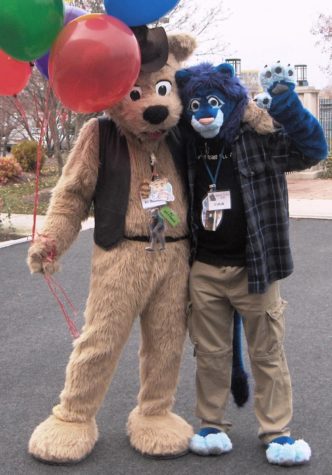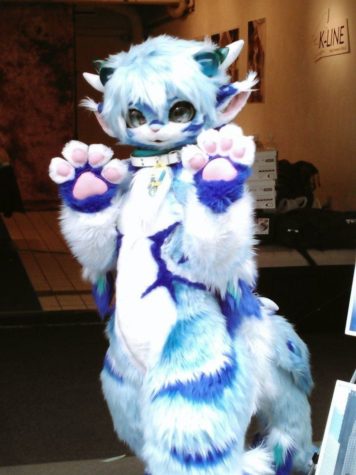What is the Furry Fandom?
From Dec. 1 to Dec. 4 of 2022, over 13,000 people invaded the town of Rosemont, Illinois, for one purpose- to attend Midwest FurFest, one of the largest furry conventions in America. Of those attendees, many dawned fursuits, which are anthropomorphic animal costumes. But why do these people wear these costumes? Is it a harmless hobby, or could it be something more?
Origins
In the early-to-mid-1980s, there was a group of friends at a sci-fi convention who bonded over anthropomorphic animals, and decided to have a ‘room party,’ a gathering of friends that usually occurs at conventions, to talk about this interest.

Years later, this small group of friends all made specific furry conventions and other events. In the 90’s, fursuits looked very different from how they look today. Because this community was still very underground, many people made their own costumes, and there weren’t any tutorials as there are today. Because of all of these factors, the quality of these suits varied, and they were often of poor quality. Despite this, the furry community continued to grow through the 90’s and the early 2000’s. Now, there are around 1.4 – 2.8 million furries worldwide, according to The Healthy Journal.
Community
The furry community is a very kind and accepting community overall. Many furries are LGBTQ+, many have autism, ADHD, and other disorders. Because of this, furries make their hobby accessible to all of those who join. Despite this kindness, the furry community has been ostracized by many parts of the internet, and the public opinion of furries is overall very negative. However, most negative comments and assumptions made about furries are completely false. Also, the online presence of furries is a very positive place. Many furries present on social media make posts about spreading positivity and normalizing talking about mental health. A lot of this content is also child-friendly, which tends to be rare on social media. Overall, the online and in-person furry community is a very welcoming place.
Fursuit Creation
Fursuits today are the pinnacle of artistic creation, involving countless hours of work and hundreds of dollars in fur and craft foam. For those who don’t have the artistic talent to create a fursuit, they commission one from a fursuit maker, an artist who makes a career by bringing a furry’s character to life. Depending on the maker, a fursuit can cost anywhere from $1000 to $10,000. To help decrease the cost, some people commission partials, or only buy certain parts of a suit. Partials usually do not include the bodysuit, the most expensive part to make. This can bring the price down to about $700 to $800, depending on the maker. There are also a few different recognised styles of suits, called Toony, Realistic, and Kimono.
A Toony fursuit shares a style with American cartoons, and it is also the most common fursuit one sees online. That is because this style is considered the easiest to make, so there are many makers who share this style. It is considered the middle ground between the two other fursuit styles, and that’s because it has elements from both.

It has larger eyes, a large muzzle, and like the name suggests, gives dynamic personality to the suit, like a cartoon character. The next style is Realistic, and like the name, these suits emphasize making a fursuit look as realistic as possible. Smaller eyes, longer muzzles, and bigger jaws are all elements of this style, coming together cohesively to make a suit look like a real animal. The last style is Kimono, a style originated in Japan that emphasizes cute and dynamic characters. Kimono style suits, in contrast to Toony and Realistic suits, have very small muzzles. They also have very large eyes, often encased in plastic domes to have a natural shine to the eyes. To add on, Kimono also adds extra padding on the legs, called digitigrade, or ‘digi’ for short, to make the legs look more animal-like. These digi legs also add another level of cute to these already adorable suits. Layered in these styles also exist sub-styles, which usually vary from maker to maker. An example of a very recognizable fursuit maker is LavaFox, their cheap prices make their suit heads sell in high quantities, but many complain about their style as being of poor quality, having very similar-looking characters and wobbly muzzles. However, many just attribute this as being a part of LavaFox’s style. Another sub-style used by many makers is called plush, and it can be made with either a Toony or a Kimono fursuit. The point of these plush suits is to make the suit look like a stuffed animal, with big, round paws and significantly more padding. These suits also tend to cost more, as the fursuit makers have a harder time crafting this type of suit. Overall, the creation of fursuits is a very complicated process, requiring lots of hard work and dedication.
Conventions
Every year, there are over 100 furry conventions worldwide. These conventions have many different aspects, depending on the convention size. Panels, meetups, room parties, dance competitions, raves, and other events are all parts of furry conventions. A very large part of conventions are the dance battles and competitions, which have been a staple of the community for many years. Because of the added difficulty of dancing in a fursuit, this is the most celebrated event at many conventions. Online, the searching for furry dance competition heeds over two hundred thousand results in videos alone. As for the panels, they are just as popular, with the highest viewed furry convention panel, a video from Anthrocon 2022 called ‘Fursiting 101,’ with over one hundred thousand views. This panel outlined how to be aware of your surroundings and your needs with the limited eyesight, the limited breathing capabilities, and the heat of being in a fursuit, which are all issues that can happen at conventions. This is why at conventions, there exists a space called a ‘headless lounge.’ The headless lounge is for people in fursuits who need to take off their suits and take a break to cool down, eat, or drink water. This room exists so the fursuiters aren’t ‘breaking the magic’ by taking their mascot heads off around children. But after the kids go to sleep, there’s tons of parties at these conventions. Room parties, which are usually between friends and happen in hotel rooms, and raves, convention-run parties where the dance floor is open to both humans and anthropomorphic animals. Because there is often alcohol at these events, they are usually for adults only. In summary, furry conventions are an exciting event where people can show off not only their beautifully crafted fursuits, but also show off the skills they already have while learning new ones.
The Robinson Furry Community
After learning about this community, one might ask- is there a furry community here at Robinson? A student who chooses to stay anonymous says, “There’s a few furries in my friend group, but there’s no Robinson ‘community’- there’s not a club or anything. In fact, I’ve been bullied for no reason because of my hobby, and the only reason I’m choosing to stay anonymous in fear of further harassment.” It is clear that people are quick to judge others, and that these harmful stereotypes exist in the Robinson community.
Summary
Overall, furries have been very misunderstood by society. To this day, furries deal with harassment, verbal and physical assault, death threats, cyberbullying, and more. In reality, furries are just normal people with a hobby- a simple interest in anthropomorphic animals. Furries are nothing like all of the offensive stereotypes- they have a kind and accepting attitude, exciting events, and an overall positive impact on the world.


